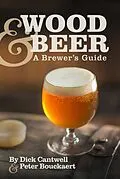Join authors Dick Cantwell and Peter Bouckaert as they tell the story of the marriage between wood and beer from Roman times through medieval Europe to modern craft brewing. Cooperage is a long and venerable craft and here the authors give a description combining the evocative and technical. The smells, the heat, choosing the wood, drying, fashioning staves, steaming, firing, and assembling into a perfect container?at least perfect until the bunghole is drilled to accommodate the precious contents.
Barrels and foeders have gone from an oddity of traditional breweries to a commonplace feature at the heart of the craft brewing industry. It is estimated that 85% of US breweries now use wood as part of their process. Maintaining wooden vessels requires care and meticulous organization of cellar space. The authors discuss the vagaries of temperature, humidity, seasonal changes, mold, and evaporation, and how breweries new and old deal with these challenges. The basics of selecting, inspecting, cleaning, and maintaining barrels are detailed.
Finally, of course, the wood must be united with the beer. The complexity and variations that govern how wood imparts flavors to beer can be overwhelming. The authors guide the reader through wood's characteristic flavor compounds and the nuances of toasting and charring. Oak is the focus, American, French, and Eastern European, but other woods get their due. As well as intrinsic flavors, the microflora that take up residence in a barrel or foeder are the living, beating heart of a barrel-aged beer, able to create sour and unique beers of fascinating complexity. The authors pepper the text with stories and experiences from some of the giants of the craft brewing scene, discussing how they monitor their barrel programs and taste and blend their beers to create something truly special.
All this will inspire professional and amateur brewers alike. At the end of the book the authors give some helpful advice on wood aging for homebrewers, including the uses for chips, cubes, spirals, staves, powders ... and the odd chair leg. Get ready to embrace the mystical complexity of flavors and aromas derived from wood.
Autorentext
By Dick Cantwell and Peter Bouckaert
Inhalt
Acknowledgments
Foreword by Frank Boon
Foreword by Wayne Wambles
Introduction
1. The History of the Barrel, or There and Back Again
Romans and (Celtic) Countrymen?Wood Replaces Clay
Vessels of Wood?Barrels, Boats, and Brewing
Messages in Barrels?Regulation, the Hanseatic League, and Other Alliances of Trade
Barrels Across the World?Exploration and Industry
The Sun Also Rises?the Shifting Nature and Use of the Barrel
2. Cooperage
3. Wood & Wooden Vessels
The Wood Before Time
American Oak
European Oak
French Oak
The Oak of Other Regions
Harvesting, Splitting, Dressing, and Seasoning
Vessels of Wood?About the Size of It
Curiosities and Anachronisms?Other Wooden Vessels Used for Brewing
4. Wood Maintenance
Cellar Design?from Zero to Infinity (and Beyond)
Cellar Ambiance?Temperature, Humidity, and Other Factors
Inspecting New Barrels, and Barrels New to You
Basic Cooperage Tools
Repairing Leaks in Barrels
Evaluation and Care of Foeders
5. Flavors from Wood
Materials Extracted from Wood
Seasoning, Bending, Toasting, and Charring
What Happens When Beer Contacts Wood
More Arcane Processes and Effects of Extraction
Other Wood-Related Products and Processes You May Not Have Thought Of
6. Flavors in Wood
Sour and Sour?Skinning the Cat
Voodoo Magic?Inoculation, Re-inoculation, and Keeping It All Going
7. Blending and Culture
The Fifth Element
Appendix A
Appendix B
Bibliography
Index
